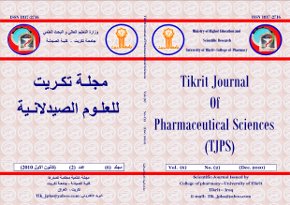Evaluation of Certain Inflammatory Markers in Transfusion Dependent β- Thalassemic Patients
Keywords:
ELISA, TNF-α, hs-CRPβ- thalassemic patients on different types.Abstract
To determine the serum concentration of certain inflammatory markers
including TNF-α and hs-CRPβ-thalassemic patients on different types of
treatmentand to investigate the possible correlation between these
inflammatory markers and iron overload referred to by serum ferritin
concentration, moreoverto assesswhether inflammation in β-thalassemia
could be controlled by deferasirox or deferoxamine as compared to
transfusion dependent patients without iron chelator. Ninety transfusion
dependent β-thalassemic children with age range 13–75 months were
included in this study, and 30 age and sex matched healthy subjects
served as control,thepatients were divided into three groups according to
the type of the treatment,each group included 30 patients Group1
comprised β-thalassemic patients without iron chelator, Group2
comprisedβ-thalassemic patients on deferasirox iron chelator while
Group3 comprisedβ-thalassemic patients on deferoxamine iron chelator.
Serum ferritin, hs-CRP, and TNF-α was measured for all participants by
ELISA method. Compared with the control, the serum level of ferritin
and hs-CRP were significantly elevated in all patients groups while the
serum level of TNF-α were only significantly elevated in Group1 and
Group3. Further analysis of the results revealed positive correlation
between serum ferritin withTNF-α and with hs-CRP.A comparison
among the patients groups show that patients on deferasirox (Group2) had
significantly low level of TNF-α as compared to Group1 and Group3. On
the other hand serum ferritin and hs-CRP concentration in Group3 were
significantly higher than the other two groups, furthermore when Group3
patients are subdivided according to their compliance on deferoxaminethe
result show that the serum level of ferritin, hs-CRP and TNF-α are
significantly higher in poor compliance subgroup as compared to good
compliancepatients and when good compliance subgroup are compared
with Group2 no significant deference in the measured parameter was
found. Chronic inflammatory state is present in these patients
withincreased levels of inflammatory markers such as TNF-α andCRP.
The observed correlations of ferritin with inflammatory markers imply
that iron overload may play a key role in release of these markers.
Chelation Therapy with deferasirox can attenuate inflammation and
reduces inflammatory markers level while deferoxamine appear to be less
effective as most patients suffer from poor compliance on this type of
iron chelator
References
Yahya HI, Khalel KJ, AL-Allawi NAS,HilmiFF (1996). Thalassemia genes in Baghdad-Iraq. East Mediterr Health J; 2 (2): 315-9.
Jalal SD, Al-Allawi NA,Faraj AH, Ahmed NH (2008). Prevalence of haemoglobinopathies in Sulaimani–Iraq, Dohuk Medical Journal; 2 (1): 71-9.
Marengo-Rowe AJ (2007). The thalassemia and related disorder, Bayl Univ Med Cent; 20 (1): 27–31.
Basak AN (2007), The Molecular Pathology Of β-Thalassemia in Turkey, Hemoglobin; 31 (2):233–41.
Dubey AP, Parakh A, Dublish S. (2008). Current Trends in the Management of β-thalassemia. Indian J. Pediatr; 75 (7): 739-43.
Porter JB (2001). Practical management of iron overload. Br J Haematol; 115(2) 239-52.
Vichinsky E (2009), Iron Overload and Iron Chelation Therapy in Pediatric Patients, US Hematology; 2(1):64-67
O’Reilly RJ, Angelucci E, Walters M, Chirnomas D (2008). Strategies for the Management of Iron Overload in the Transplant Setting, Clinical Advances in Hematology & Oncology; 6 (5) Supplement 11.
Kwiatkowski JL (2011). Management of transfusional iron overload –differential properties and efficacy of iron chelating agents. Journal of Blood Medicine; 2: 135-49
Nielsen F, Mikkelsen BB, Nielsen JB, Andersen HR, Grandjean P. (1997), Plasma malondialdehyde as biomarker for oxidative stress: reference interval and effects of life-style factors. Clinical Chemistry; 43:1209–14.
Friedman JS, Lopez MF, Fleming MD, Rivera A, Martin FM, et.al (2004). SOD2-deficiency anemia: protein oxidation and altered protein expression reveal targets of damage, stress response, and antioxidant responsiveness. Blood; 104 (8):2565–73.
Pradhan AD, Cook NR, Buring JE, Manson JE; Ridker PM (2003). C-reactive protein is independently associated
Downloads
Published
How to Cite
Issue
Section
License
Copyright (c) 2025 THIS IS AN OPEN ACCESS ARTICLE UNDER THE CC BY LICENSE http://creativecommons.org/licenses/by/4.0/

This work is licensed under a Creative Commons Attribution 4.0 International License.
This is an open-access journal, and all journal content is available for readers free of charge immediately upon publication.






